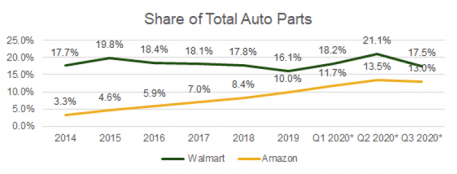Whole Paycheck: Walmart And Amazon Have A Food Fight
New research from PYMNTS into seven key retail categories where Amazon and Walmart compete shows the online giant is closing in on its rival’s lead in auto parts, one of the last segments where Walmart still enjoys a lead — other than food, where it still dominates.

According to the report, the auto parts market share spread between Walmart and Amazon has slipped to just 4.5 percent, with the Bentonville, Arkansas retailer seeing its portion slide to 17.5 percent in the third quarter of 2020, the most recent data available.
At the same time, Amazon has seen its auto parts sales steadily rise over the past five years, rising from just 3.3 percent in 2014 to 13.0 percent in Q3 of 2020.
Head To Head Heating Up
Besides gasoline sales, which could have been positively affected by the 5-cent per gallon discount for Walmart+ program members, Walmart saw share decreases versus Amazon in every category, from auto parts and sporting goods, to health and personal care, to clothing and apparel.
The Tracker study found that Walmart’s food and beverage share also slipped sequentially in Q3, from 19.3 percent to 18.1 percent, while its leadership position still marked a 10x margin over Amazon’s 1.8 percent share in the segment. That said, the report points out that Amazon’s acquisition of Whole Foods stores in 2017 has failed so far to expand its sales in food, or meaningfully chip away at Walmart’s lead, although it has permitted the eCommerce leader to set a foothold on the market.
Overall Slippage
While the head-to-head battle between the two retail leaders is clearly trending in Amazon’s favor, both companies saw their share of total US retail spending decline for the first time ever.
Walmart’s total share of U.S. retail spending fell to 8.7 percent in Q3 from 10.2 percent in Q2, while Amazon saw its portion of US sales pull back to 8.7 percent during Q3 versus 9 percent in Q2.
“It was a quarter that any retailer besides Amazon and Walmart would be happy to take in the U.S.,” the report noted. “But it’s clear from the data and anecdotal evidence that the ‘Amazon effect’ and the ‘Walmart effect’ might be losing their power.”
Amazon’s Electronics Juggernaut
Just as Walmart dominates the grocery segment by a seemingly unassailable margin, Amazon’s control of the electronics and appliances segment is equally formidable.
According to the Q3 Tracker data, while Amazon’s Q3 gross sales in the electronics and appliances category rose 7.4 percent to $23.2 billion, its share of the overall spending actually slipped to 23.7 percent from 24.4 percent in Q2. Still, the share is almost four times Walmart’s 5.1 percent share of electronics — which also fell from 6.0 percent in Q2.
However, when the numbers are limited to only share of eCommerce sales, Amazon’s Q3 portion hit 46.5 percent, which was nearly five full percentage points higher than Q2.
“Amazon didn’t show any significant vulnerabilities in Q3. Its pattern was slight drops in share of consumer spending and 3 percent to 5 percent increases in share of eCommerce spend,” the report found.
With Amazon’s record-breaking Q4 and FY 2020 results now in the books, as well as founder Jeff Bezos stepping away from day-to-day duties as CEO, the focus will now shift to Walmart’s holiday haul, which will be reported on Feb. 18 before the markets open.

